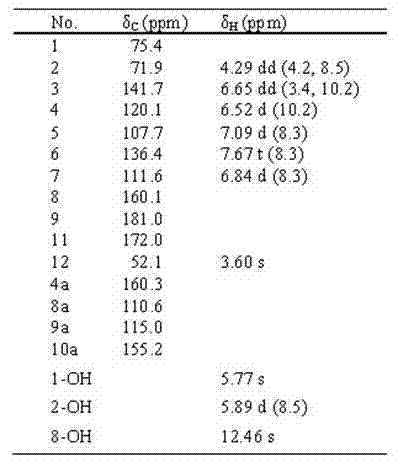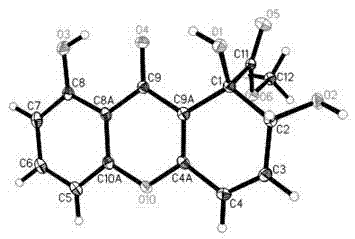Xanthone compounds and applications thereof
A technology of xanthones and compounds, which is applied in the field of microbial drugs, can solve the problems of separating and obtaining peroxyxanthone compounds, and achieve the effect of obvious inhibitory effect
- Summary
- Abstract
- Description
- Claims
- Application Information
AI Technical Summary
Problems solved by technology
Method used
Image
Examples
Embodiment 1
[0018] The separation and preparation of the xanthone compounds of the present invention:
[0019] 1. Pseudomonas scutellaria Paraconiothyrium Incline culture of sp. YM311593 strain: Peel potatoes, cut into small pieces, add water to boil, filter with gauze to obtain potato filtrate, then add glucose and agar, use distilled water to make up volume, sterilize to obtain slant medium; Make a test tube slant, pick the YM311593 bacterial strain and insert it into the slant medium for culture to obtain the slant bacterial strain;
[0020] 2. Seed culture of Pseudomonas scutellaria YM311593 strain: Take a strain graft block from the above-mentioned slant strains and inoculate it into PDB medium (PDB medium: 200 g of peeled potatoes, 20 g of glucose, 15 g of agar, 1000 g of distilled water mL, natural pH, sterilized at 121°C for 30 minutes), cultured on a shaker at 28°C and 200 r / min for 3 days to obtain seed solution;
[0021] 3. Liquid fermentation culture of Pseudomonas scutel...
Embodiment 2
[0024] The MTT method is used to detect the anti-tumor cell activity of the xanthone compound of the present invention.
[0025] 1. Test method: Select four kinds of tumor cells in the logarithmic growth phase, adherent human lung adenocarcinoma cell A549, human cervical cancer cell Hela, human colon cancer cell HCT-8, and human liver cancer cell Bel7402, and digest them with trypsin, respectively. Use RPMI1640 culture medium with 10% calf serum to prepare a cell suspension of 15,000 cells / ml, inoculate 190 μl per well in a 96-well culture plate, and inoculate at 37°C, 5% CO 2 Cultivate for 24h. In the experimental group, 10 μl of fermentation broth extract sample with a concentration of 100 μg / ml was added, and the final volume of each well was 200 μl, which was supplemented with 1640 culture medium. 37°C, 5% CO 2 Culture 3d. The supernatant was discarded, and 100 μl of freshly prepared 0.5 mg / ml MTT serum-free culture solution was added to each well, and cultured at 37°C ...
Embodiment 3
[0029] The anti-phytopathogenic fungus activity of the xanthone compound of the present invention is detected by a micro double dilution method.
[0030] 1. There are four strains of pathogenic indicator bacteria: Tobacco Alternaria Alternaria ( Alternaria alternata ), Gibberella wheat ( Gibberella saubinettii ), Apple Anthracnose ( Colletotrichum gloeosporioides ), Curvularia maize ( Curvularia lunata ).
[0031] 2. Test method: Add 1 ml of sterile water to the solid slant culture medium with indicator bacteria, shake for a while to make indicator bacteria suspension. Dissolve the sample to be tested in dimethyl sulfoxide, prepare a sample solution with a concentration of 512 μg / ml, add the sample to a 96-well cell plate, and dilute the sample to a final concentration of 1 μg / ml by the micro-double dilution method . Then add the bacterial suspension to each well in turn, put it in an incubator at 25°C and incubate for 48 hours, observe with the naked eye, and take th...
PUM
| Property | Measurement | Unit |
|---|---|---|
| Half inhibitory concentration | aaaaa | aaaaa |
| Minimum inhibitory concentration | aaaaa | aaaaa |
Abstract
Description
Claims
Application Information
 Login to View More
Login to View More - R&D
- Intellectual Property
- Life Sciences
- Materials
- Tech Scout
- Unparalleled Data Quality
- Higher Quality Content
- 60% Fewer Hallucinations
Browse by: Latest US Patents, China's latest patents, Technical Efficacy Thesaurus, Application Domain, Technology Topic, Popular Technical Reports.
© 2025 PatSnap. All rights reserved.Legal|Privacy policy|Modern Slavery Act Transparency Statement|Sitemap|About US| Contact US: help@patsnap.com



